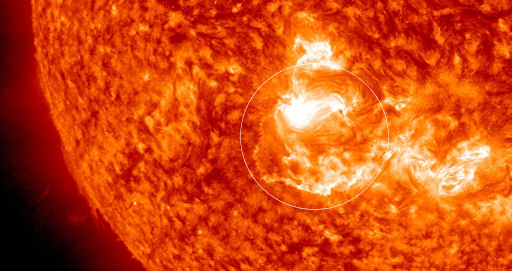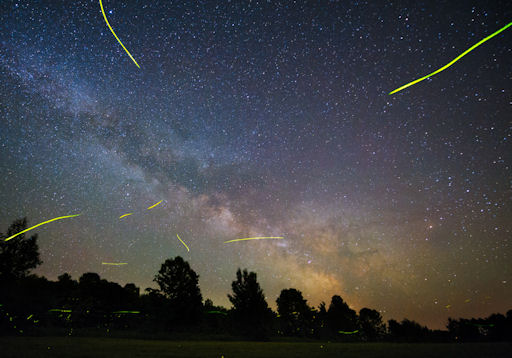Metallic photos of the sun by renowned photographer Greg Piepol bring together the best of art and science. Buy one or a whole set. They make a stellar gift. | | | CHANCE OF FLARES: NOAA forcasters estimate a 40% chance of M-class solar flares today as a phalanx of sunspots turns toward Earth. The most likely source of geoeffective eruptions is sunspot AR1504, which has grown into an active region almost 10 times wider than Earth. Solar flare alerts: text, voice. As predicted, the sunspot has flared. Magnetic fields above AR1504 erupted on June 13th at 1319 UT, producing a long-duration M1-class solar flare. NASA's Solar Dynamics Observatory recorded the extreme UV glow of the blast: 
The ongoing explosion is taking hours to unfold, which means it is very powerful despite its middling M1-peak. Long duration flares often hurl coronal mass ejections (CMEs) into space, and this one is probably no exception. Stay tuned for updates about a possible Earth-directed CME. SUMMER LIGHTS: The signs of northern summer are beginning to appear in the skies over Canada. "For one thing, I can see the ISS several times each night as it flys through the solstice sunlight high above Earth," reports Guillaume Poulin of Cookshire, Québec, "Second, fireflies are very active. And finally I can see the Milky Way at 11 pm in shirt-sleeve weather." He documented the scene on June 12th: 
Aware that a minor geomagnetic storm was underway, "I quickly framed my camera and started a 2 minute exposure in which I recorded the ISS, the Milky way, a swarm of fireflies, and the faint glow of the subsiding aurora. What a beautiful night!" Realtime Space Weather Photo Gallery
[Submit your photos] [NASA videos: 2012 Transit of Venus, ISS Transit of Venus] Potentially Hazardous Asteroids ( PHAs) are space rocks larger than approximately 100m that can come closer to Earth than 0.05 AU. None of the known PHAs is on a collision course with our planet, although astronomers are finding new ones all the time. On June 13, 2012 there were 1311 potentially hazardous asteroids. Notes: LD means "Lunar Distance." 1 LD = 384,401 km, the distance between Earth and the Moon. 1 LD also equals 0.00256 AU. MAG is the visual magnitude of the asteroid on the date of closest approach. | | The official U.S. government space weather bureau | | | The first place to look for information about sundogs, pillars, rainbows and related phenomena. | | | Researchers call it a "Hubble for the sun." SDO is the most advanced solar observatory ever. | | | 3D views of the sun from NASA's Solar and Terrestrial Relations Observatory | | | Realtime and archival images of the Sun from SOHO. | | | from the NOAA Space Environment Center | | | the underlying science of space weather | | 
